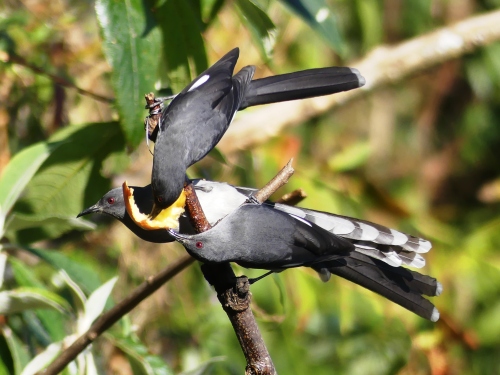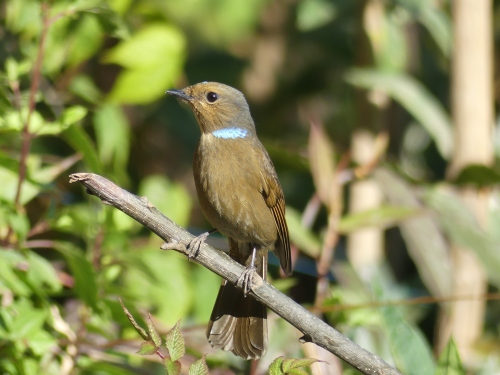If I’d died and gone to birding heaven, it couldn’t have been much better than Baihualing. If you have been to South America and seen antpittas and other shy forest birds come to worms when called, imagine that. Except that it lasts all day rather than five minutes. The bird blinds/feeding stations at Baihualing are amazing. Each blind (or “hide” as the Brits say) is owned by a local who created and manages it. A good location is identified and then the blind owner creates a stage for the birds with water features, logs and stumps that can be filled with suet or worms, places to perch, etc. On one side is the hide – a narrow rectangular tent-like structure with either a long window or portholes for binoculars and cameras and little plastic stools for sitting.
I envision the creation process is much like that of a male bowerbird who looks at his stage from various perspectives. Will the birds find it appealing and come? Will the birders and photographers in the blind have good views? Ongoing management consists of chauffeuring birders back and forth between the hotel and the blind, feeding the birds throughout the day, and collecting the modest fees that birders and photographers pay for the privilege of wonderful close looks at birds that would otherwise be very difficult to find and see well. It’s a winning situation for everyone, including the birds.
We arrived at this wonderful place late in the afternoon of January 23th and spent nearly two hours in Blind #8. Here are some of the gorgeous birds we saw that first day.

Red-billed Leiothrix. I missed this beautiful little bird on previous trips to China, so I was thrilled to finally get such a wonderful close look this time.

Red-tailed Laughingthrush. It’s hard to believe, but these beauties were common at the blinds with half a dozen or so frequently in the feeding areas.

Chestnut-headed Tesia. What a little charmer! This is a species that would have been difficult to see well “in the wild.”
Space prohibits displaying all of my photos from that afternoon, so here is a link to my eBird checklist.
The next morning we walked a nearby trail for over six hours. It was advertised as “flat,” but several of us thought it was a bit steep and I didn’t stay with the group the entire time. I didn’t see many birds on the trail, but I did see a beautiful Black Giant Squirrel which was so big that I didn’t even realize it was a squirrel at first.
Later that afternoon, I was happy to spend two hours in Blind #77. In that short time, I got eight life birds! Here are a few of my favorite photos from the afternoon.

Red-tailed Minla. Such a smart and sophisticated-looking bird. I can’t help assigning human-like personalities to some of these exotic Asian birds.

Black-streaked Scimitar-Babbler. I have been awed by scimitar-babblers ever since I first saw a Gray-sided Scimitar-Babbler in 2012. And, what a struggle it was to see that first one. Scimitar-Babblers are normally very shy birds.

Scarlet-faced Liocichla. These gorgeous birds were fairly common and we frequently saw them with Red-tailed Laughingthrushes.
And, here is my eBird checklist from that session with more photos.
The next day, January 25, we spent the entire day in the blinds starting with #35 in the morning. Some species seem to be constantly present at a blind and others come and go throughout the day. Some of the shyer birds may only come once or twice a day – or skip a day entirely. A few photos from that session:

Blue-winged Lauthingthrush. Gorgeous and a little scary looking. Very shy compared to Red-tailed Laughingthrushes.

Ashy Drongo. He came into the feeding area like he owned it, with grace and confidence, but no arrogance. Yep, I can’t help those human comparisons. Drongos are common in China and the others didn’t get excited over them, but I loved them, especially this species.
Streaked Spiderhunter is a species that we enjoyed seeing from the blinds, but this is one that we also saw well several times “in the wild.” Presumably, these birds do feed on spiders and insects, but that long curved bill is adapted for obtaining nectar. National Geographic even includes them in its list of Top 25 Birds with a Sugar Rush.

Silver-eared Mesia. These beautiful little birds are currently doing well in the wild, however, the population is under pressure from trapping for the caged bird trade.
Here is my eBird checklist from the morning.
We spent the afternoon in Blind #11, at a little higher elevation than the others we had visited, which produced a few new species. Each blind has its specialties. At this one, new birds were Hill Partridge and Gray-sided Laughingthrush. This blind was the only location where we saw either of these species.
My eBird checklist from Blind #11 has more photos.
On our final morning at Baihualing, we all had a choice – walk the trails to search for species that don’t come to the blinds or have another session at a blind. You can guess which option I choose. It turned out to be a good decision as the others dipped again on their second try for Gould’s Shortwing, a difficult species to find. Additionally, our little group in the blind had wonderful looks at eight Mountain Bamboo-Partridges, the only good sighting of this species during the trip.
That last morning, we also had excellent looks at many species seen during the previous few days. A few of my favorites were the birds below.

Mr. Orange-bellied Leafbird. I had seen these gorgeous birds on previous trips, but I was thrilled to get much closer looks this time.
Here is my last eBird checklist from Baihualing, but there are six more days in the Zoothera Birding trip and then a week in Shenzhen, so I’ll be back with more stories.




















